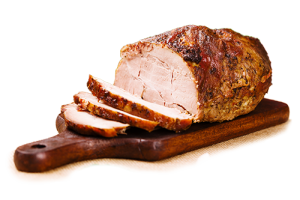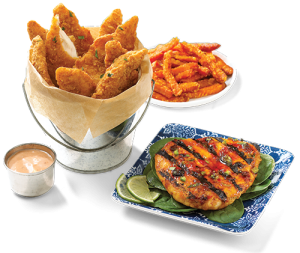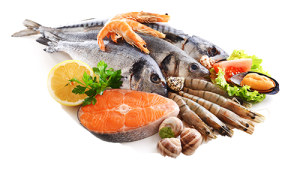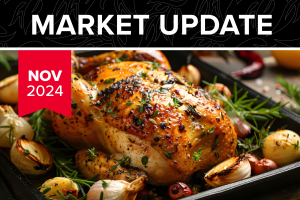Your monthly update on the state of the pork, poultry, beef, and seafood industry, direct from the category experts at Y. Hata.
Please contact your account manager for questions.
Pork

The harvest numbers for hogs are still strong with plenty of hogs available although storm conditions in the Midwest and Northeast caused some disruption in getting them to the processors.
- Bellies are on the steady to firmer side due to active retail.
- Rib demand remains strong both in retail and foodservice. Expect to pay asking prices and more.
- Butts are a challenge, there is plenty of product but labor limitations to fabricate boneless is affecting the price, which is seen in the spread between bone in and boneless of $.30 and more. Normally that spread would be $.15-$.25 lb.
An uncertain outlook on pork due to:
- Philippines importing pork due to African swine fever (ASF) decimating their industry.
- Numerous cases of ASF have been reported in wild boars in Germany who is one of Europe’s largest producers of pork and a major supplier to China. China has banned importing of pork from Germany.
- There are reports coming out of China of new strains of ASF that has set back their efforts to rebuild their herd which may prompt them to import more pork from the US and other countries not affected by ASF.
Poultry

As shared earlier, the days of low chicken prices have ended, at least temporarily. We are seeing prices of all parts increasing upwards of $.10-$.30 lb. The exception to that is tray pack thighs and leg quarters but that will follow shortly.
- BL SL thighs moved up $.20 quickly and appears to have a more upwards trend.
- Jumbo random breast is up $.30 and remains tight. Buyers are having to pay asking prices or higher.
- Wings likewise are still in high demand, especially jumbo, and in short There are no good deals to find.
Future outlook on poultry will be most impacted by:
- Although demand remains strong, the farmers have adjusted their output to be more in line with demand and not have excessive product.
- Feed prices have risen considerably recently, and corn is up 33%.
- A significant number of export contracts were closed and that will have an impact on product availability and price over the next few months.
Beef

Despite rising Covid-19 case counts in the U.S, in January the overall supply of beef remains steady. However, the demand for prime grade cuts, specifically ribs and striploins, has remained robust leading to higher prices and limited supply.
- Ribs: After prices bottomed out towards the end of January, prices have been steadily increasing with retailers stepping into book product for future.
- Striploins: After being low during the holiday months, prices have taken a sharp rise over the past few weeks with steak processing operations buying product for future.
- Tenderloins: Foodservice demand still has not returned due to dining restrictions in place nationwide. However, retail demand at the big box stores (Costco & Sam’s Club) has increased recently resulting in higher prices leading up to the Valentines Day week with more people choosing to prepare a meal for their significant other at home.
- Top Sirloin: We saw the low point in late December and can expect moderate increases as we head into spring.
- Briskets: The price has increased $.40 since the beginning of the year due to increased demand from foodservice operators focused primarily on take out business. In addition, the relatively affordable price of briskets has proven quite attractive for foodservice operators who are looking for value during these challenging economic times.
- Chuck Flats: Pricing has continued to increase due to the overall strength of the current chuck roll market and international market with South Korea primarily stepping in. This has led to tighter supply and increased cutout Current price for February is $5.85 but will be increasing to $6.27 in March.
- Oxtails: Prices continue to remain high as supplies remain limited and suppliers continue to find buyers meeting their asking price. The supply of Mexican beef which is traditionally a major source of oxtails has improved over the past few weeks, but this additional supply has yet to impact prices in the market yet. Although our pricing will be decreasing by $.20 lb. this month, we do not expect a more significant drop in prices until we approach the summer months.
Outlook
- Moving forward as foodservice starts to open back up more fully and with more people getting vaccinated, we can possibly expect potential supply chain issues as packers shifted their production to cater more to the retail segment during this pandemic.
Seafood
 King Crab
King Crab
- Remain at record-high prices due to shortages of raw material.
- Red King Crab – limited raw material available at extremely high prices.
- Gold King Crab – minimal to no raw material available. Expect more product to become available mid/end March.
- Customers are turning to more affordable crab options such as Opilio Snow Crab and Deep-Water Snow Crab causing these prices to rise as well.
Snow Crab
- 8UP Canadian Snow Crab is unavailable until new season – May/June.
- Very limited 8UP Alaskan and Russian product available at extremely high prices – $14-16/lbs.
Dungeness Crab
- Whole Cooked Dungeness crab are unavailable due to high levels of domoic acid in the body of the crab.
- However, Dungeness Clusters are available.
Soft Shell Crab
- The weather is not favorable for Soft Shell Crab farming. The temperature is too cold, causing the mortality rate to increase to 40-50%.
- Expect prices to start increasing as raw material becomes short.
Lobster
- Cold Water Lobster Tail and CK Meat prices continue to rise due to strong retail demand and inconsistent landings.
- Warm Water Lobster Tail prices have been soft as a result of COVID, however the prices are starting to climb as people substitute these for the Cold Water Tails.
- New season product will not become available until June so the prices will steadily rise due to limited inventory.
Fin Fish
- Salmon
- Expect a gradual price increase through Easter (April 2020) because of holiday and lent demand.
- Mahi mahi market is strengthening for both Taiwan and South American product.
- The catch in Taiwan and Peru has decreased over 50% causing there to be a shortage in raw material.
- Due to COVID, many processors switched their focus to retail items. This has driven up the price for portions.
Squid
- There is a worldwide shortage of all squid species (loligo, illex, arrow).
- For the past 5-7 years, squid landings have decreased year over year.
- Not sure if this is due to global warming (warmer ocean temperatures) or new migratory patterns but fisherman have not been successful in finding squid.
Protein Market Update
The protein industry has made great strides in changing how they operate their facilities due to COVID- 19 yet there are still challenges ahead, some of which they have some control and others beyond their control. Below are some of the factors that could affect availability and prices near term:
- Shipping containers – a reduced supply of containers is causing disruptions on importing of seafood from other countries. This is also affecting packaging materials i:e: boxes, containers, lids, plastic, film, etc.
- Corn and wheat prices have taken a significant increase and will have the greatest impact on poultry, pork and
beef prices, in that order. - African Swine Fever in Europe and China may cause them to turn to importing U.S pork.
Labor continues to be a challenge not only in the U.S. but other parts of the world. Everyone is hopeful the vaccination will be the game changer we all need.



